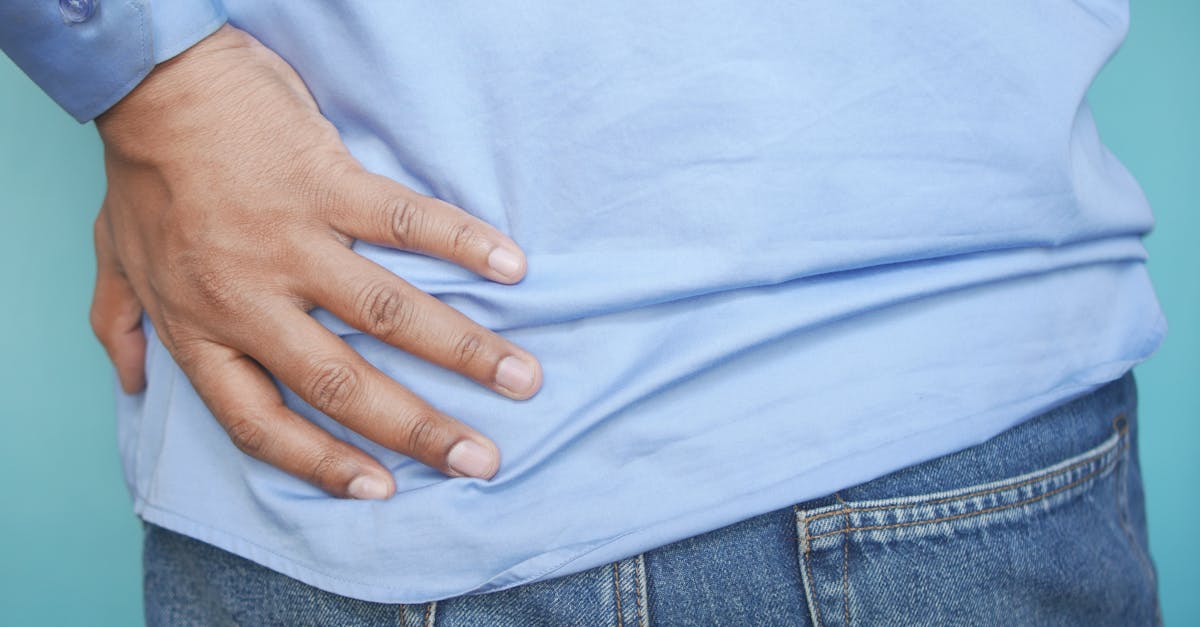Suffering from tension headaches and migraine pain? Yoga can be your ally.
In Short: Maximize Yoga for Headaches offers natural headache remedies to relieve migraine and tension headaches effectively. By integrating subtle adjustments into your yoga practice, you can manage migraine triggers and reduce headache causes, leading to improved overall well-being. Experience the calming benefits of yoga, enhancing your body’s ability to combat chronic migraines and hormonal headaches. Embrace this holistic approach to headache relief today! Reclaim your health and wellness at Pulse Align Clinics. BOOK YOUR APPOINTMENT today!
Are you struggling with lower back pain and poor posture?
Imagine experiencing headache relief while enhancing your yoga practice. By learning how to maximize yoga for headaches, you can integrate Pulse Align’s subtle adjustments effectively. These modifications not only aim to provide migraine relief and address tension headaches, but also offer a comprehensive approach to manage common headache causes. Did you know that studies show a significant number of adults experience chronic migraines and related discomfort? Discover how Pulse Align’s method can lead to better alignment and body awareness, aiding in managing migraine triggers and even hormonal headaches. Don’t let issues like neck pain and nausea with headache hold you back any longer; explore this path towards wellness today.

“`html
In our fast-paced lives, many of us encounter various forms of discomfort and imbalance, often stemming from poor posture and muscle tension. Unveiling innovative approaches to well-being, we explore how neuromuscular recalibration can play a significant role in improving posture and restoring natural balance. One such approach that deserves attention is the gentle, supportive methodology offered by Pulse Align.
Understanding the Pulse Align Approach
Pulse Align employs gentle stimulation that fosters muscles to recalibrate, effectively promoting muscle tone symmetry. This holistic technique embraces the body’s innate capacity for healing, emphasizing the importance of achieving functional alignment. By encouraging optimal posture, Pulse Align works to address the factors contributing to discomfort, providing clients with an avenue to enhance their overall well-being. This method represents a harmonious blend of technology and nature, positioning itself as a leading choice for those seeking natural improvement.
The Benefits of a Holistic Wellness Journey
Clients often express appreciation for the holistic benefits associated with the Pulse Align practice. Such treatments not only focus on addressing tension but also advocate a comprehensive wellness journey that enhances physical and emotional health. By integrating Pulse Align’s techniques, many individuals have reported a noticeable change, including the ability to improve posture naturally and reduce feelings of discomfort, particularly in the neck and back. Each session is tailored to create a serene environment where clients feel supported and empowered in their journey toward balanced health.
Experience the Pulse Align Difference
“Since starting my sessions with Pulse Align, I have noticed a remarkable improvement in my posture and feel more at ease overall,” shares a satisfied client. These sentiments mirror numerous testimonials highlighting the success of this gentle approach to well-being. As clients embrace the principles of natural balance, they discover newfound freedom from discomfort and tension.
Ready to Enhance Your Well-Being?
If you’re in Montreal, La Prairie, Terrebonne, Chicoutimi, Charlesbourg, Saint-Jérôme, Châteauguay, Sainte-Marie, Les Escoumins, Granby, or Panama City, consider taking the first step toward your wellness journey with Pulse Align. Visit our website to book a consultation and explore how our services can elevate your health and posture without substituting your existing healthcare team. Ready to experience how gentle neuromuscular recalibration can enhance your life? Find a Pulse Align clinic near you today!
- Focus on Breath: Enhance breathing techniques to improve relaxation and reduce tension.
- Mindfulness Integration: Incorporate mindfulness practices into yoga sessions for greater body awareness.
- Gentle Adjustments: Utilize subtle physical adjustments to align the body and relieve pressure.
- Consistent Practice: Establish a daily routine to build resilience against headache triggers.
- Environmental Awareness: Create a calm space that minimizes external stressors during practice.
- Personalized Approach: Tailor yoga poses to individual needs based on specific headache triggers.
- Community Engagement: Join a supportive yoga group to share experiences and coping strategies.
- Regular Assessments: Continuously evaluate progress and triggers to adapt your practice.

“`html
Managing headaches effectively often requires a blend of holistic approaches. By leveraging yoga in harmony with Pulse Align’s specific adjustments, individuals seeking headache relief can experience significant improvement in their overall well-being. This article explores the essential components of integrating yoga practices with neuromuscular health techniques, providing pathways to alleviate migraines, tension headaches, and chronic headaches.
Understanding Headache Causes and Triggers
Headaches can present in various forms, such as migraine pain, cluster headaches, and menstrual migraines. Common headache causes include stress, poor posture, inadequate sleep, and hormonal changes. By addressing the underlying issues through yoga and other methods, we can reduce prevalent migraine triggers and work towards preventing future episodes systematically.
The Holistic Benefits of Yoga
Yoga not only helps in enhancing physical flexibility but also plays a vital role in posture correction and core strengthening. Practicing yoga promotes better body alignment, reducing unnecessary pressure on the head and neck, which can contribute to tension headaches. Integrating specific trunk exercises into your routine through tailored yoga sessions can substantially improve body mechanics, thereby relieving symptoms associated with headaches.
Integrating Pulse Align’s Techniques
Pulse Align’s emphasis on holistic recalibration ensures that individuals can attain balance in their physical health. By understanding the relationship between the nervous system and headache conditions, we can apply precise adjustments that not only mitigate symptoms but also enhance overall body function. For instance, essential oils for headaches can be introduced within yoga sessions to create a calming atmosphere that aids in migraine relief. The combination of physical activity with sensory engagement fosters a state of relaxation vital for reducing discomfort.
Effective Practices and Recommendations
To maximize the benefits of yoga for headaches, consider implementing the following strategies:
- Focus on Breathing Techniques: Incorporate slow, intentional breathing practices like alternate nostril breathing to promote relaxation and harmonize brain activity.
- Utilize Yoga Poses: Repeated practice of poses such as Child’s Pose or Downward-Facing Dog can target muscle tension areas, alleviating pain associated with headaches.
- Explore Mindfulness: Integrate meditation or mindfulness techniques while performing yoga to heighten your awareness of potential headache causes and triggers.
Call to Action: Start Your Journey to Relief
Are you ready to transform your approach to headache management? Schedule a consultation with Pulse Align to explore personalized exercise plans designed for optimum neuromuscular health and incorporate effective yoga techniques into your routine. Find out how our specialized programs can effectively address your unique headache symptoms and be a part of a supportive community striving for holistic wellness.
| Yoga Technique | Pulse Align Adjustment Benefits |
|---|---|
| Child’s Pose | Enhances relaxation, reduces stress tension |
| Copper Pose | Increases blood flow, calms the nervous system |
| Bridge Pose | Improves posture, alleviates cervical discomfort |
| Plow Pose | Stretches spine, releases muscle tightness |
| Downward Dog | Boosts energy, minimizes headache triggers |
| Standing Forward Bend | Reduces pressure, enhances relaxation |
| Headstand | Improves circulation, balances energy flow |
| Breath Awareness | Increases body awareness, aids trigger recognition |
| Pranayama | Regulates stress responses, promotes calmness |

Discovering Wellness Through Maximize Yoga for Headaches
“I’ve struggled with migraines for years, and I can’t believe the impact Maximize Yoga at Pulse Align has had on my wellness journey. The subtle adjustments offered here truly align with the body’s natural ability to recalibrate. I’ve felt noticeable improvements in my stress levels and headache frequency. Living in Châteauguay, I couldn’t have asked for a better resource to help me regain control over my life.” – Sarah M.
“As someone who has dealt with chronic headaches for over a decade, the unique approach at Pulse Align has been a godsend. The integration of yoga techniques with holistic care has allowed me to experience relief that feels natural. I appreciate the focus on restoring balance in the body. For those in areas like Sainte-Marie or Deux-Montagnes, I highly recommend giving this a try!” – Jason T.
“Maximize Yoga has transformed how I handle my migraines. The supportive environment at Pulse Align plays a vital role in my healing process. The personalized adjustments I receive help me connect with my body’s healing mechanisms. For individuals in Mont-Royal, you should definitely explore the benefits offered here!” – Clara L.
“Before discovering Pulse Align, I didn’t realize the significant connection between my physical posture and my headache patterns. After attending Maximize Yoga sessions, my body has found a new equilibrium. Residents of Terrebonne would greatly benefit from these sessions as they truly emphasize holistic recovery and wellness!” – Martin Z.
“I was skeptical at first, but the results speak for themselves. The practices taught at Pulse Align have helped me reclaim my life from debilitating headaches. It’s fascinating to see how my body is starting to work in harmony again. For anyone in Saint-Jérôme, I can’t recommend this enough!” – Emily A.
Pulse Align collaborates with your healthcare team to support not just you, but your entire family on this progressional journey. For further information on how to access our services, please visit Our Clinics. Whether you’re in Chicoutimi or Les Escoumins, a brighter, more balanced future is just around the corner.
Our Mission
At Pulse Align, our mission is to deliver evidence-based, client-centered treatments that address the underlying causes of pain and dysfunction. By integrating advanced techniques and technologies, we strive to empower each person to take control of their health, ensuring a high standard of care, lasting relief, and an improved quality of life.
Have you considered the benefits of practicing yoga as a means of finding relief from migraines and headaches? Numerous studies suggest that yoga can serve as a powerful natural alternative to medication in managing this common disorder, which affects approximately 13% of the global population. Migraines can lead to severe symptoms that disrupt daily life, such as nausea, sensitivity to light, and throbbing headaches, making it vital to explore various methods of relief.
According to health experts, engaging in a regular yoga practice has been linked to a decrease in the frequency and intensity of migraine attacks. A recent study from 2021 supports the idea that mindfulness-based stress reduction, often practiced through yoga, plays a significant role in managing migraines. Incorporating yoga into your self-care routine may help alleviate symptoms by enhancing stress relief, improving sleep quality, and managing body weight, which are essential factors in triggering migraine episodes.
While yoga poses, or asanas, are certainly a cornerstone of practice, it is important to remember that breathing exercises and meditation are just as crucial in managing headaches. Techniques like alternate nostril breathing can aid in calming the mind and body, allowing for enhanced interoceptive awareness—an ability that helps you identify migraine triggers and effectively manage them.
It is also essential to recognize that different individuals may experience varying results when practicing yoga for migraine relief. This highlights the importance of exploring different poses and techniques tailored specifically to your needs. For beginners, starting with a few minutes of daily practice may lead to beneficial outcomes over time. Certified yoga instructors can offer guidance, ensuring that you develop a personal and safe approach to your practice.
Here are 10 yoga poses that can provide relief from migraines:
– Child’s pose (‘Adho Mukha Virasana’)
– Corpse pose (‘Savasana’)
– Bridge pose variation (‘Chatush Padasana’)
– Plow pose (‘Halasana’)
– Breathing exercises (‘Pranayama’)
– Standing forward fold pose (‘Uttanasana’)
– Downward-facing dog pose (‘Adho Mukha Svanasana’)
– Legs up the wall (‘Viparita Karani’)
– Shoulderstand (‘Salamba Sarvangasana’)
– Headstand (‘Sirsasana’)
By integrating yoga and breathing exercises into your routine, you may discover an effective path for reducing migraine symptoms and enhancing your quality of life. Should you choose to explore yoga as a treatment option, it is advisable to consult with your healthcare provider to ensure its safety and appropriateness for your specific condition. Together, we can cultivate a supportive community dedicated to raising awareness about migraines and advancing wellness practices.
Learn more about his approach and available services at www.pulsealign.com and find a location near you here: https://pulsealign.com/our-locations/
Transform Your Life with TAGMED’s Spinal Decompression Technology
TAGMED is proud to offer advanced Spinal Decompression Therapy, a non-surgical solution meticulously designed to alleviate chronic pain stemming from moderate-to-severe disc issues. Whether you’re suffering from a herniated disc, bulging disc, or even conditions like spinal stenosis, our technology focuses on gently reducing pressure on affected discs and nerves. This specialized technique aims to enhance mobility, alleviate discomfort, and support your body’s natural healing process. If you’ve reached a plateau with other therapies, discover how TAGMED’s evidence-based decompression approach can help you resume an active, comfortable life.
Have you tried conventional treatments and still struggle with persistent back pain due to a severe disc condition?
Mechanism of Action
TAGMED’s neurovertebral decompression applies a controlled, progressive traction force to the spine. This method increases the space between vertebrae, effectively reducing pressure on intervertebral discs and nerve roots. Consequently, it promotes better fluid circulation in the targeted area. This unique process not only lowers inflammation but also relieves pain, offering a reliable, non-invasive solution for individuals dealing with chronic back pain.
Specific Benefits
This non-invasive approach is particularly effective for alleviating chronic pain associated with conditions such as herniated discs or spinal stenosis. By reducing pressure on crucial nerve structures and optimizing fluid circulation around the discs, TAGMED’s neurovertebral decompression can hasten recovery and enhance the quality of life for those seeking relief from relentless discomfort. Patients report experiencing significant improvements in mobility and overall wellness.
Comparison with Other Treatments
Compared to standard treatments like pain medications, corticosteroid injections, surgeries, or traditional physiotherapy, TAGMED’s neurovertebral decompression technology stands out. Its non-invasive nature minimizes medication-related risks while providing a potentially faster path to recovery. Additionally, it serves as a compelling choice for those looking for safer, evidence-based alternatives.
Case Studies or Testimonials
Real-world examples highlight the effectiveness of TAGMED’s neurovertebral decompression for chronic pain. Many patients have shared testimonials about their journeys, depicting lasting pain relief, rapid return to daily activities, and a marked decrease in their reliance on pharmaceuticals. These firsthand accounts illustrate the tangible results and practical advantages of this therapeutic approach.
Unlocking Wellness Through Holistic Alignment
If you’re looking to enhance your overall well-being and find natural pain relief, consider the holistic approach of Pulse Align. By focusing on posture correction and neuromuscular recalibration, our methods support your body’s innate healing abilities, allowing for improved posture and an increase in mobility.
Clients have shared their positive experiences with Pulse Align, highlighting how our gentle and non-invasive approach has significantly reduced discomfort and fostered a sense of well-being. They appreciate the tailored solutions designed with their unique needs in mind, which empower them to enjoy greater freedom in their daily lives.
Take the first step toward a healthier, more balanced you. Schedule your consultation now and discover the Pulse Align difference today. Embrace a path toward wellness where you can truly thrive, backed by our commitment to your holistic health and vitality.

Do you suffer from a chronic condition that responds little or not at all to conservative treatments?
In our modern lives, many individuals seek solutions beyond traditional methods, especially when it comes to well-being and managing discomfort. Pulse Align introduces an innovative, non-invasive approach designed to restore the body’s natural balance and posture through gentle, imperceptible pulses. This method has the potential to alleviate muscle and joint tension, creating a harmonious environment for the body to nurture its innate healing abilities.
Rather than focusing directly on discomfort or specific conditions, Pulse Align supports your body’s natural recalibration processes. This often leads to remarkable enhancements in overall comfort and improved posture. Clients frequently share how they feel revitalized and more balanced, as their bodies realign toward a state of equilibrium without the use of any drastic interventions.
What sets Pulse Align apart is its personalized and compassionate approach. Clients who have experienced sessions often express their gratitude for the attention they receive and the improvements they notice in areas such as neck and back tension, while enjoying a sense of relaxation and wellness. They also appreciate the family-friendly environment where everyone, from children to pregnant women, can experience a gentle and supportive journey toward well-being.
We invite you to explore the transformative possibilities with Pulse Align. Visit our website to learn more, discover nearby locations such as La Prairie, Mont-Royal, and Terrebonne, and book a consultation that suits your family’s needs. Remember, Pulse Align complements, rather than replaces, any healthcare services you may be receiving. Our approach is safe and aligned with your overall wellness journey. To learn more about our services and book an appointment, visit our website: Pulse Align.
Frequently Asked Questions
Headache and Migraine
- Do coenzyme Q10 or magnesium help?Some studies suggest magnesium or coenzyme Q10 supplements may reduce migraine frequency.
- Can migraines be mistaken for other conditions?Yes, some migraines mimic stroke or sinusitis symptoms. A medical diagnosis may be needed.
- What are common causes of headaches?Stress, fatigue, dehydration, muscle tension, sleep disorders, or too much caffeine can trigger a headache.
- Do strong smells trigger migraines?Yes, certain strong odors (perfume, solvents) can provoke or worsen attacks.
- Does cognitive-behavioral therapy help?Yes, it teaches stress and pain management techniques, reducing migraine frequency and intensity.
- Do migraines decrease after menopause?Often, migraine frequency reduces after menopause due to hormonal stability, but not always.
- Do children get migraines?Yes, children can experience migraines, often shorter but just as painful.
- Are migraines hereditary?Yes, the predisposition to migraines can be genetic, making some people more susceptible.
- Do massages help with headaches?A gentle scalp, neck, or shoulder massage can relieve muscle tension and ease a headache.
- Do migraines increase stroke risk?Migraines with aura slightly raise stroke risk, especially in women who smoke and use hormonal contraception.
Ethan Dubois is dedicated to shining a light on the hidden struggles of chronic headaches. As a Headache Awareness Advocate at Pulse Align, he combines compassionate storytelling with cutting-edge research to bring clarity, comfort, and hope to those affected. Ethan’s mission is to empower readers with knowledge, break through stigma, and foster a supportive community where every voice is heard. When he’s not crafting insightful articles, Ethan can be found exploring the latest wellness trends, sharing practical coping strategies, or simply lending a listening ear to those in need. His heartfelt approach and unwavering commitment to awareness make him a trusted ally for anyone navigating life with headaches.
References
- Lin, L.-Z., Yu, Y.-N., Fan, J.-C., Guo, P.-W., Xia, C.-F., Geng, X., Zhang, S.-Y., & Yuan, X.-Z. (2022). Increased stiffness of the superficial cervical extensor muscles in patients with cervicogenic headache: A study using shear wave elastography. Frontiers in Neurology, 13, 874643. https://www.frontiersin.org/articles/10.3389/fneur.2022.874643/full
- Fernández-de-las-Peñas, C., Cuadrado, M., & Pareja, J. (2006). Myofascial Trigger Points, Neck Mobility and Forward Head Posture in Unilateral Migraine. Cephalalgia, 26(9), 1061–1070. https://doi.org/10.1111/j.1468-2982.2006.01162.x
- Aoyama, N. (2021). Involvement of cervical disability in migraine: a literature review. British Journal of Pain, 15(2), 199–212. https://doi.org/10.1177/2049463720924704
- Balaban, M., Celenay, S. T., Lalecan, N., Akan, S., & Kaya, D. O. (2024). Morphological and mechanical properties of cervical muscles in fibromyalgia with migraine: A case-control study. Musculoskeletal Science and Practice, 74, 103185. https://www.sciencedirect.com/science/article/pii/S2468781224002807
- Kolding, L. T., Do, T. P., Ewertsen, C., & Schytz, H. W. (2018). Muscle stiffness in tension-type headache patients with pericranial tenderness: A shear wave elastography study. Cephalalgia Reports, 1, 2515816318760293. https://doi.org/10.1177/2515816318760293
- Choi, S.-Y., & Choi, J.-H. (2016). The effects of cervical traction, cranial rhythmic impulse, and Mckenzie exercise on headache and cervical muscle stiffness in episodic tension-type headache patients. Journal of Physical Therapy Science, 28(3), 837–843. https://www.jstage.jst.go.jp/article/jpts/28/3/28_jpts-2015-893/_article/-char/ja/
- Florencio, L. L., De Oliveira, A. S., Carvalho, G. F., Tolentino, G. D. A., Dach, F., Bigal, M. E., Fernández‐de‐las‐Peñas, C., & Bevilaqua Grossi, D. (2015). Cervical Muscle Strength and Muscle Coactivation During Isometric Contractions in Patients With Migraine: A Cross‐Sectional Study. Headache: The Journal of Head and Face Pain, 55(10), 1312–1322. https://doi.org/10.1111/head.12644
- Ashina, S., Bendtsen, L., Lyngberg, A. C., Lipton, R. B., Hajiyeva, N., & Jensen, R. (2015). Prevalence of neck pain in migraine and tension-type headache: A population study. Cephalalgia, 35(3), 211–219. https://doi.org/10.1177/0333102414535110
- Yu, Z., Wang, R., Ao, R., & Yu, S. (2019). Neck pain in episodic migraine: a cross-sectional study. Journal of Pain Research, Volume 12, 1605–1613. https://doi.org/10.2147/JPR.S200606
- Al-Khazali, H. M., Al-Sayegh, Z., Younis, S., Christensen, R. H., Ashina, M., Schytz, H. W., & Ashina, S. (2024). Systematic review and meta-analysis of Neck Disability Index and Numeric Pain Rating Scale in patients with migraine and tension-type headache. Cephalalgia, 44(8), 03331024241274266. https://doi.org/10.1177/03331024241274266
- Calhoun, A. H., Ford, S., Millen, C., Finkel, A. G., Truong, Y., & Nie, Y. (2010). The Prevalence of Neck Pain in Migraine. Headache: The Journal of Head and Face Pain, 50(8), 1273–1277. https://doi.org/10.1111/j.1526-4610.2009.01608.x
- Bjarne, B. (2024). NECK MUSCLE ELASTICITY IN CERVICOGENIC HEADACHE PATIENTS MEASURED BY SHEAR WAVE ELASTOGRAPHY [PhD Thesis, Ghent University]. https://libstore.ugent.be/fulltxt/RUG01/003/202/979/RUG01-003202979_2024_0001_AC.pdf
- Martínez-Merinero, P., Aneiros Tarancón, F., Montañez-Aguilera, J., Nuñez-Nagy, S., Pecos-Martín, D., Fernández-Matías, R., Achalandabaso-Ochoa, A., Fernández-Carnero, S., & Gallego-Izquierdo, T. (2021). Interaction between pain, disability, mechanosensitivity and cranio-cervical angle in subjects with cervicogenic headache: A cross-sectional study. Journal of Clinical Medicine, 10(1), 159. https://www.mdpi.com/2077-0383/10/1/159
- Hvedstrup, J., Kolding, L. T., Ashina, M., & Schytz, H. W. (2020). Increased neck muscle stiffness in migraine patients with ictal neck pain: A shear wave elastography study. Cephalalgia, 40(6), 565–574. https://doi.org/10.1177/0333102420919998
- Al-Khazali, H. M., Younis, S., Al-Sayegh, Z., Ashina, S., Ashina, M., & Schytz, H. W. (2022). Prevalence of neck pain in migraine: A systematic review and meta-analysis. Cephalalgia, 42(7), 663–673. https://doi.org/10.1177/03331024211068073
- Luedtke, K., Starke, W., & May, A. (2018). Musculoskeletal dysfunction in migraine patients. Cephalalgia, 38(5), 865–875. https://doi.org/10.1177/0333102417716934
- Pradhan, S., & Choudhury, S. S. (2018). Clinical characterization of neck pain in migraine. Neurology India, 66(2), 377–384. https://journals.lww.com/neur/fulltext/2018/66020/clinical_characterization_of_neck_pain_in_migraine.19.aspx
- Fernández-de-las-Peñas, C., Madeleine, P., Caminero, A., Cuadrado, M., Arendt-Nielsen, L., & Pareja, J. (2010). Generalized Neck-Shoulder Hyperalgesia in Chronic Tension-Type Headache and Unilateral Migraine Assessed by Pressure Pain Sensitivity Topographical Maps of the Trapezius Muscle. Cephalalgia, 30(1), 77–86. https://doi.org/10.1111/j.1468-2982.2009.01901.x
- Zwart, J. (1997). Neck Mobility in Different Headache Disorders. Headache: The Journal of Head and Face Pain, 37(1), 6–11. https://doi.org/10.1046/j.1526-4610.1997.3701006.x
- Fernández‐de‐las‐Peñas, C., Cuadrado, M. L., & Pareja, J. A. (2007). Myofascial Trigger Points, Neck Mobility, and Forward Head Posture in Episodic Tension‐Type Headache. Headache: The Journal of Head and Face Pain, 47(5), 662–672. https://doi.org/10.1111/j.1526-4610.2006.00632.x




